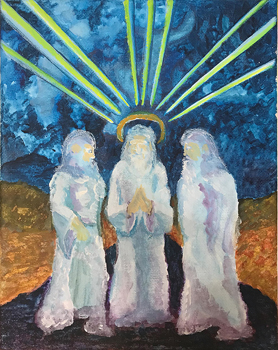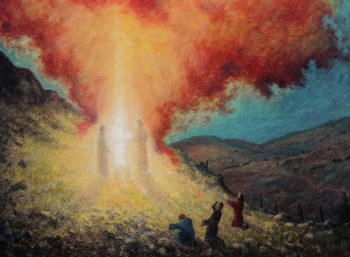From Our Archive
Debie Thomas, "The Limp and the Blessing" (2020); Dan Clendenin, "He Felt Compassion" (2017) and "The Nation of Israel as the People of God" (2014).
For Sunday August 6, 2023
Lectionary Readings (Revised Common Lectionary, Year A)
Genesis 32:22–31 or Isaiah 55:1–5
Psalm 17:1–7, 15 or Psalm 145:8–9, 14–21
Romans 9:1–5
Matthew 14:13–21
This Week's Essay
Year A of the Revised Common Lectionary in 2023 is somewhat special this week. Our readings about the Transfiguration of Christ appear on the last Sunday in Epiphanytide. But the Feast of the Transfiguration is universally celebrated across Western and Eastern communions on August 6th. Normally, this day falls during the week, but this year, it comes on a Sunday. So while we have listed the ordinary RCL readings for this Sunday, the lectionary essay will join the Church universal in celebrating the Feast of the Transfiguration. For those preaching on the RCL texts, please see our archived essays highlighted above.
I am an opera lover. I relish its soaring vocals, rousing music, sumptuous sets and dance choreography, and the rich literary traditions that stand behind opera’s monumental creations. Yet I am far from an expert on opera. I barely rate as a connoisseur. My interest in the opera is a pleasurable respite, dipping into a piece from time to time. While I understand music, I know little about the precision that maps the vocals to the music to the story. I certainly do not understand opera the way a professional singer or art critic or orchestra conductor grasps the fuller genius of a particular piece.
Still, I do understand some of it, and I find opera satisfying in a manner that many other people do not. For some, there is little difference between opera and a screeching cat in an auditorium. Think of all the jokes made about opera in popular entertainment, whether it’s singers breaking glass windows or “fat ladies” signaling the end of a sports event. Some people simply cannot hear the art as art — it’s boring, or obnoxiously loud, or utterly incomprehensible.
Listening to opera happens on a spectrum. What is actually heard is ambiguous depending on the refinement of the listener’s ear. Those with no tolerance or grasp of opera at all do not really hear it; for them, it’s a cacophony, not art. For those like me, we enjoy a great deal about the opera, and relish in a performance’s execution and composition. Yet we are unlike those who have fully trained in the art and who can appreciate all of its facets to a degree that I can only pine for.
A moment’s reflection suggests that the phenomenon being described — the wide range of “what is heard” by those listening to the same opera — applies throughout our lives. Close friends can perceive each other’s character in a way that acquaintances or strangers cannot. Most of us can only taste a couple flavors in a cola soda, while professional quality control tasters rate a cola along more than 40 areas of measurement! Out in the wilderness I merely observe birds, while a practiced bird watcher observes particular varieties of birds. In every case, multiple people can be looking or tasting or hearing the same objects of interest, and yet some will simply be unable to perceive the features or qualities that others perceive.
 |
These remarkable facts about human life call into question a very common assumption. We tend to think that we either perceive things or we don’t. When thinking of empirical observation, we adopt what Sarah Coakley calls a “flat” view of the world. We’ll believe it when we see it—that is, only when we can perceive with our own senses that something is real will we believe it. But this assumes that we are all looking at the world with the same kinds of sense perception. What if that is not true? What if the world looks and sounds and feels differently depending on how refined or degraded our senses are?
What if, for example, quibbles between atheists and religious folk over the existence of God have as much to do with having learned how to perceive God’s reality as it does over evidence for belief in God? Perhaps the issue lies with what kind of eyes we’re looking for God.
Sarah Coakley suggests that diversity in sensual refinement may help to explain our intractable social problems. What if, she proposes, our struggles with racial conflict, misogyny, ubiquitous pornography, or devaluing the poor remain difficult to contain much less eradicate because we as humans have defective vision when we look at other people? Instead of seeing fully equal people bearing the image of God, we see inferiors, sexual fantasies, or sub-human objects for exploitation. The problem is not just in what we believe but in how we perceive other people, much less the non-human creatures with whom we share this generous planet.
On this Feast of the Transfiguration, thinking about perception as more or less refined might radically alter how we think about the Transfiguration of Jesus in the presence of Peter, John, and James. It sounds like a narrative about something that happened to Jesus. There he was, praying like an ordinary human, and then all of sudden the divine stage lights came on and Jesus lit up like a Taylor Swift concert. Jesus starts glowing while Moses and Elijah are magically returned from the dead.
What if instead the Transfiguration was not an alteration to Jesus, but rather a change in the three disciples who were there watching. After months of living with Jesus and serving in his company, their eyes finally became refined enough to see Jesus in his majesty. In seeing Moses and Elijah next to Jesus their eyes were becoming spiritually mature enough to see that in Jesus the law and the prophets are fulfilled.
This doesn’t mean there was no Transfiguration — nothing is being explained away. We’re simply relocating the Transfiguration from a change happening to Jesus into a change happening to the disciples in which the Holy Spirit showed them who Jesus was all along. The Transfiguration happened, but what was transfigured was the spiritual perception of Peter, John, and James.
They were seeing the Incarnate Christ stand before them on that hillside. While they probably only understood as much of the Incarnation as I do opera, at least they had graduated to being able to see the Incarnation at all. Someone standing alongside the disciples who had not yet developed eyes sufficiently refined to see Jesus as the image of the Father would not have seen what Peter, John, and James saw. St. Paul writes in 2 Cor. 4.4 that “the god of this age has blinded the minds of unbelievers, so that they cannot see the light of the gospel that displays the glory of Christ, who is the image of God.” When someone does see the glory of Christ, it is a work of the Spirit, who has made “light shine in our hearts to give us the light of the knowledge of God’s glory displayed in the face of Christ” (v. 6).
 |
Well-meaning folks, desiring to uphold historical Christian belief, will assert that what the three disciples saw on that hillside was simply that Jesus is God. Beneath his seemingly human exterior was some kind of pulsating fusion reactor of divine light and power. Jesus had some human characteristics but really he was an omniscient mind with unlimited sovereignty who existed before the world began.
Except that isn’t what the Church has historically taught. For Christians, Jesus is fully God and fully human. An over-zealous insistence on Jesus’ divinity undermines the completeness of his humanity. When we look at the stories of Jesus in the four canonical gospels, we see a truly human Jesus, as human as every person he walked the countryside of Galilee with. It is in defense of this very human Jesus that some writers like Marcus Borg have perhaps over-corrected in the other direction, insisting that since Jesus is so thoroughly human in the gospels he could not have been fully God. Borg hypothesizes that Jesus became divine after his death and resurrection, but wasn’t divine while he lived a human life. An ingenious proposal, it nonetheless fails to do justice to the magnificent vision of glory these three disciples saw in the human life of Jesus.
These over-corrections in both directions suggest that the problem isn’t sincerity but perception. Those who defend Jesus’ divinity are not looking at Jesus with eyes that can see his divine glory in his humanity. Those who defend Jesus’ complete humanity are not looking at Jesus with eyes that can see his divine glory in his humanity. How much discord between Christians might have more to do with our inability to perceive theological truths?
As our eyes become transfigured by the power of the Holy Spirit to see Jesus in his glory, we gain the ability to see Jesus as fully divine and fully human. I close with an excerpt from Austin Farrer’s homily, “The Incarnation,” which captures what it is about Jesus all Christians are learning how to see.
We cannot understand Jesus as simply the God-who-was-man. We have left out an essential factor, the sonship. Jesus is not simply God manifest as man; he is the divine Son coming into manhood. What was expressed in human terms here below was not bare deity; it was divine sonship. God cannot live an identically godlike life in eternity and in a human story. But the divine Son can make an identical response to his Father, whether in the love of the blessed Trinity or in the fulfilment of an earthly ministry. All the conditions of action are different on the two levels; the filial response is one.
God is not manifest the same way in the eternity of the heavenly Trinity as on the earth in the life of a creature. In heaven, the Son displays an eternal obedience out of love to the Father. On earth, Jesus of Nazareth displays a human obedience out of love to the Father. In heaven, the Son is fully divine; on earth, Jesus is fully human. Yet these are not two individuals, nor two distinct acts — they are one act done by one individual seen in two different contexts, one above and one below. Jesus enacts for us what the divine life simply is. He lives a life that is of one being with the Father, because he is the earthly form of the Son’s heavenly union with the Father.
 |
We’re tempted to think that if Jesus is a completely normal human, then he could not have be God for us. We suppose that the more human Jesus is, the less divine he can be. But “there is no contradiction between a man ‘living’ God and God ‘living’ a man” (John A. T. Robinson). Jesus is as completely human as Marcus Borg insists — which is no barrier to the historical Jesus doing what the Son eternally does.
If we find ourselves reading these last few paragraphs and still not “getting it,” perhaps we only need eyes with which to see. Rather than dismissing the Incarnation as “unbelievable,” we can learn how to see Jesus in all his glory. The whole function of weekly worship together as the Church is to attune our sensibilities toward Christ. May we trust that these truths are good and holy and pray for God to transfigure our senses until we too can see the majesty of Jesus our Lord.
– Sarah Coakley quotations taken from her recent book Sensing God?; Austin Farrer quotation taken from his book The Brink of Mystery; John A. T. Robinson quotation from his book on the Incarnation, The Human Face of God.
Weekly Prayer
R.S. Thomas (1913–2000)
Via Negativa
Why no! I never thought other than
That God is that great absence
In our lives, the empty silence
Within, the place where we go
Seeking, not in hope to
Arrive or find. He keeps the interstices
In our knowledge, the darkness
Between stars. His are the echoes
We follow, the footprints he has just
Left. We put our hands in
His side hoping to find
It warm. We look at people
And places as though he had looked
At them, too; but miss the reflection.R.S. Thomas was born in Cardiff in 1913, the only child of Huw and Margeret. The family settled at Holyhead. He was awarded a bursary in 1932 to study at University College, Bangor, where he read Classics. In 1937 he was ordained as a priest in the Anglican Church in Wales. For twelve years, from 1942–54, Thomas was rector at Manafon. It was at this time that he published his first book of poetry, The Stones of the Field. In 1940 he married Mildred Eldridge, an English artist, they were to be married until her death in 1991. They had one son.
Michael Fitzpatrick welcomes comments and questions via m.c.fitzpatrick@outlook.com
Image credits: (1) Dominic Martinelli; (2) Pixels.com; and (3) AbsoluteArts.com.





